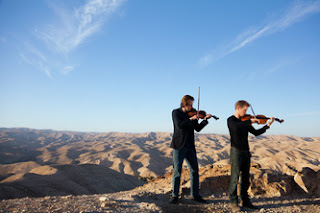 If you haven't already met them, then meet my friends Fifth Quadrant and Dal'Ouna. Fifth Quadrant is a go-ahead young British chamber ensemble featuring, amongst others, Simon Hewitt Jones and Drew Balch (left, photo by Ian Dingle). Dal'Ouna, from Ramallah, is an ensemble of Palestinian musicians led by Ramzi Aburedwan, director of the inspirational music school Al Kamandjati (=The Violinist). The Road to Jericho brings both ensembles together for joint concerts and projects with young musicians in Britain and the Palestinian Territories. This week they're working in Snape with Aldeburgh Young Musicians and tomorrow I'm off there to see how it's all going. More shortly about the forthcoming evening with all of them that opens the Spitalfields Festival.
If you haven't already met them, then meet my friends Fifth Quadrant and Dal'Ouna. Fifth Quadrant is a go-ahead young British chamber ensemble featuring, amongst others, Simon Hewitt Jones and Drew Balch (left, photo by Ian Dingle). Dal'Ouna, from Ramallah, is an ensemble of Palestinian musicians led by Ramzi Aburedwan, director of the inspirational music school Al Kamandjati (=The Violinist). The Road to Jericho brings both ensembles together for joint concerts and projects with young musicians in Britain and the Palestinian Territories. This week they're working in Snape with Aldeburgh Young Musicians and tomorrow I'm off there to see how it's all going. More shortly about the forthcoming evening with all of them that opens the Spitalfields Festival.This Saturday afternoon, 4 June, at 3pm, please come and join us at the Mosaic Rooms, Earl's Court, for a discussion about music-making and musical education in the Palestinian Territories. Simon is planning to webcast the debate live at the Road to Jericho website - and possibly right here on JDCMB as well (assuming he can conquer my technotwitdom). I'll be chairing a panel discussion featuring Simon, Ramzi and the filmmaker, broadcaster and author Dennis Marks, and we'll be inviting questions from our live audience and also our virtual audience via Twitter. Admission is free (though donations are welcome) and there'll be refreshments and a short performance by Dal'Ouna. Watch this space for more details!
Here is a little something to whet the appetite: this is one of the pieces I wrote following my trip to the West Bank in the week of the ash cloud a year ago - when I met one of the most musical kids I've ever seen in my life.
ISSA’S DABKE
Foot-stamping, boot-tramping,
Mood to dance! A time to dance!
Mood to dance! A time to dance!
Stamp and jump, and keep the beat,
Dabke dance, we need to dance!
Bare the floor and bare the window
Cracked the floor and blank the window
Linked the arms and dark the hair,
Themed by scarves, and teamed by dance
Mood to dance! A time to dance!
Teenaged boys don’t dance in England,
But here they’re men in dance and drive,
Dance their life and dance their soul,
Dance their team and dance their dream -
But where’s the music? We have none,
Blank the floor and bare the window
Jump and stamp, the music’s blank.
And there in a corner sits the guest:
A western violinist.
…“Play us something so we can dance!
…Play us something that sounds Arabic!”
…But the violinist stands helpless,
…He can’t play anything but Mozart and Tchaikovsky…
Issa calls the need to dance,
Issa leads the time to dance,
Issa’s burning up with dance,
Issa’s music lives within
And Issa’s mind will find a way.
Bare the floor and blank the windows
But music’s in the mobile phone!
Rig it up and blast the windows!
Tape it up and stamp the floor!
Tape it up and stamp the floor!
Damn the fiddle and stream the music,
Mood to dance! A time to dance!
Energy will find its way.
The violinist taps a toe,
The violin will learn to play.
© Jessica Duchen, 2010


